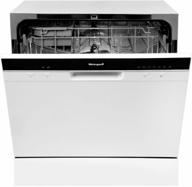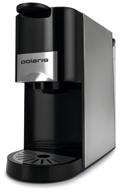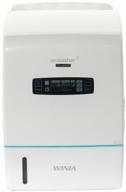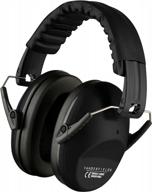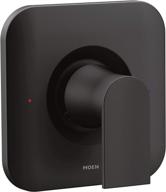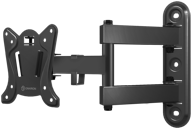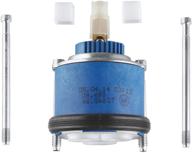Troubleshooting Common Faucet Problems
Having issues with your faucet? Faucet problems are common in most homes, but they can often be fixed with some basic troubleshooting and DIY repair. Here are some of the most common faucet problems and how to solve them.Similar products
Dripping Faucet
A dripping faucet is one of the most common problems. There are a few potential causes:- Worn washers - The washers inside the faucet handles wear out over time. Replacing them is an easy DIY fix.
- Damaged valve seats - Mineral deposits can damage the valve seats inside the faucet body, causing drips. Scrubbing the seats or replacing valves may help.
- Loose connections - Ensure all connections under the sink are tight.
Another interesting products
Low Water Pressure
If your faucet flow seems weaker than normal, there are a few things to check:- Clogged aerator - Unscrew the aerator at the tip of the faucet and remove any debris.
- Partially closed supply valves - Make sure the shutoff valves under the sink are fully open.
- Blocked supply lines - Sediment in the supply tubes can reduce water flow.
Leaky Handles
Water leaking around the faucet handles has a quick fix:- Replace the O-ring seals inside the handles - Pop off the decorative handle caps and replace the O-rings if worn.
Squeaky Faucets
A few options for stopping faucet squeaks:- Lubricate the faucet valves and stems using faucet lubricant or silicone grease.
- Adjust or replace worn rubber valve seats and springs.
- Replace faulty washers.
Loose Spouts
If the faucet spout is wobbly, simply tighten the retaining nut holding it to the sink. If this doesn't work, you may need a new faucet.Clogged Aerator
Low flow or spraying from the aerator points to buildup of sediment and minerals. To fix:- Unscrew the aerator at the tip of the faucet.
- Rinse out any debris in the screen and flow restrictor.
- Reassemble and reattach the aerator.
Fixing a Dripping Faucet
A leaky, dripping faucet can waste hundreds of gallons of water per year and cause staining and mineral buildup in your sink. Here’s how to stop a dripping faucet in a few simple steps.Causes of Dripping Faucets
A faucet drip is usually caused by one of these issues:- Worn washers or O-rings - The rubber washers and O-rings inside the faucet handles and valves compress over time, leading to leaks and drips. Replacing them is an easy fix.
- Damaged valve seats/springs - Mineral deposits can damage the valve seats and springs inside faucet bodies. The valves and seats may need scrubbing or replacement.
- Sediment buildup - Small pieces of sediment can become lodged in faucet valves, causing drips.
How to Fix a Dripping Faucet
Here are the basic steps for repairing a leaky faucet:- Turn off water supply lines under the sink and open the faucet to relieve pressure.
- Pry off the decorative cap on the handle and remove the handle screw. Pull the handle off.
- Unscrew the retaining nut holding the cartridge or assembly in place using pliers or a basin wrench.
- Examine washers, O-rings, valve seats, and springs. Replace any worn parts.
- Scrub or scrape any sediment or mineral deposits off the valve seat.
- Reassemble the faucet. Replace handles and turn water back on. Test for leaks.
Troubleshooting Low Water Pressure from Your Faucet
NOTICEABLY low water flow from your faucet can make tasks like washing dishes frustrating. Here are some common causes and fixes for low faucet pressure.Causes of Low Water Pressure
There are a few usual suspects behind decreased water flow:- Clogged aerator - Mineral buildup and sediment clog the mesh aerator screen at the faucet tip, restricting water flow. An easy fix is removing and cleaning the aerator.
- Partially closed supply valve - Check under the sink that the water supply valves are fully open. Partially closed valves limit water flow.
- Kinked supply lines - Flow is reduced if the flexible supply lines are tightly kinked or bent under the sink.
- Low house water pressure - Whole home water pressure problems caused by the main line or municipal supply affects all faucets.
Increasing Water Pressure at the Faucet
Here are step-by-step tips for improving low faucet water pressure:- Clean the aerator - Unscrew the aerator at the faucet tip and rinse debris from the screen. Reassemble and test water flow.
- Check supply valves - Remove cabinet panels and ensure shutoff valves under the sink are fully open.
- Check supply lines - Inspect along supply tubes for kinks and bends that restrict flow. Straighten lines.
- Flush faucet and lines - Disconnect supply lines and open the faucet to flush any sediment from valves.
- Replace cartridge or assembly - If other fixes don't work, low pressure may be from worn internal parts. Replace the faucet cartridge.
Top Tips for Maintaining Your Faucets
Taking care of your faucets with regular maintenance can prevent leaks, drips, and other problems. Here are some useful tips for keeping faucets in good working condition.Clean Faucets Regularly
Mineral deposits from water and soap scum can build up on faucet surfaces, valves, and aerator screens. Give faucets a thorough cleaning every few months:- Wipe down faucet exteriors using a non-abrasive cleaner and damp cloth.
- Soak detachable aerators and valves in vinegar or lime deposit cleaner to remove buildup.
- For heavier deposits, use a toothbrush to scrub valves and hard-to-reach areas.
Top products in 🚰 Faucet Parts
Fix Drips Right Away
Don't ignore a faucet drip! Leaks can worsen quickly and cause major issues. Replace worn washers, O-rings, valve seats, or cartridges as soon as drips develop.Replace Internal Parts Regularly
Rubber washers, O-rings, valve seats and springs wear out over time. Inspect these regularly and replace every 5-10 years or at the first sign of drips.Lubricate Parts
Prevent squeaks and sticking by lubricating faucet valves and stems every year using plumbers grease or silicone faucet grease.Tighten Connections
Check under the sink to make sure all water supply line connections are tight at least annually. Tighten couplings with an adjustable wrench as needed.Adjust Water Temperature
If faucet handles are erratic or water temperature fluctuates, adjust the thermostatic limit stop underneath. Consult manufacturer instructions.Inspect Exterior Surfaces
Look for wear, cracks, and damage to exterior faucet parts from time to time. Replace components like handles, lift rods, spray heads, and spout mounts as needed.With proper maintenance and care, most faucets should provide years of reliable service. Don't wait for problems to occur - a little preventive maintenance goes a long way.Why You Should Fix Faucet Drips Immediately
A small, persistent drip from your bathroom or kitchen faucet can seem harmless. But even minor faucet leaks should be repaired right away to prevent bigger problems down the road.Drips Can Lead to Bigger Leaks
A slight faucet drip often indicates worn washers, O-rings, valve seats or other internal parts. These drip-inducing issues will continue degrading if left unaddressed. A minor drip can quickly turn into a major leak, potentially causing water damage, mold issues, and high water bills.Drips Waste a Lot of Water
Even small drips can waste dozens or hundreds of gallons over weeks and months. A leak flowing at just one drop per second wastes nearly 3,200 gallons per year. Fixing drips promptly conserves water and saves on your utility bills.Mineral Buildup Can Occur
The constant flow of water from a drip deposits mineral sediment on faucet components. These calcium and lime deposits can damage washers, aerators and valves. Repairing the drip immediately helps prevent this added wear and tear.Drips Cause Surface Damage
Allowing water to drip constantly in one spot can damage your sink or counter material. Drips can leave behind stains, mineral etching, and eroded areas on porcelain and natural stone surfaces. Quick faucet repairs reduce this risk.Bacteria and Mold Can Grow
The moisture from faucet leaks encourages growth of mold, mildew and bacteria in sink basins and drains. This creates unsanitary conditions and potential health hazards. Prompt leak repairs help avoid these problems.DIY Faucet Drip Repairs
Most simple faucet drips from worn washers or O-rings can be fixed in about 15 minutes with basic tools and hardware store replacement parts. Watch tutorial videos to see the repair process. With a little practice, you can become proficient at diagnosing and fixing annoying faucet drips as soon as they start.Ignoring a minor drip may seem harmless, but allowing any faucet leak to persist can lead to big trouble and expenses down the road. For environmental and financial reasons, repair drips and leaks from faucets right away.Replacing Faucet Washers and O-rings
Over time, the rubber washers and O-rings inside faucets wear out or get damaged. Replacing these parts is an easy fix for most common faucet leaks and drips.Signs You Need New Washers or O-rings
Watch for these signs that the washers or O-rings need replacement:- Dripping from the faucet spout or leaking handles
- Loss of water pressure
- Loose handle that doesn't hold temperature setting
- Noisy operation of faucet
Supplies Needed
Gather these supplies before beginning:- Replacement washers or O-ring kit
- Adjustable wrench
- Small screwdriver
- Plumbers putty or silicone sealant
Repair Instructions
Follow these steps to replace worn faucet washers and O-rings:- Turn off water supply lines and open faucet to relieve pressure.
- Pry off faucet handle caps and unscrew handle retaining screws.
- Remove handles, dome caps, cam washers, and the cartridge or valve body.
- Use needle-nose pliers to extract old washers and O-rings.
- Install new replacement washers and O-rings.
- Reassemble faucet components in reverse order.
- Turn on water supply and test for leaks.
Buying Faucet Parts with Amazon Prime
Need to repair a leaky faucet? Amazon Prime makes it easy to order faucet repair parts and supplies with fast, free shipping. Follow these tips for finding and buying quality faucet components through your Prime membership.Search for Specific Faucet Models
Amazon stocks replacement parts for many name-brand faucet models. Search using your faucet's exact model number to find compatible washers, O-rings, cartridges, and valve bodies. Matching your existing hardware ensures the right fit and performance.Use Generic Terms to Cast a Wide Net
If you don't know your faucet model, search for "faucet washers", "O-ring kit", or "faucet valve repair kit". This will show all compatible products. Narrow options by finish, material, number of washers, etc.Check Vendor Options
Big brands like Danco, DANCO, and American Standard sell faucet repair kits on Amazon. But check options from other vendors too. Read product reviews carefully when considering less familiar brands.Compare Prices
Amazon lists price options from various sellers on most product pages. Take a minute to compare prices and shipping charges on the same item. Prime members often get the best deals from Amazon direct.Look for Discount Bundles
Many vendors offer money-saving combo packs with an assortment of common replacement parts. A faucet repair kit with O-rings, washers, screws and seals can provide everything you need in one purchase.Don't Forget the Tools
Add a basin wrench, plumber's putty, silicone grease, and other handy tools to your order. Having the right equipment will make your repair job easier.With thousands of eligible products available with fast Prime shipping, Amazon is a great resource for DIY faucet repair supplies. Take advantage of your membership to order exactly what you need to fix leaky faucets with ease.p>Bathroom Faucet Replacement Parts
If you need to replace parts of your bathroom faucet, there are many options available. Here are some places to find bathroom faucet replacement parts:
How To Identify The Right Replacement Part For A Bathroom Faucet??
Identifying the right replacement part for a bathroom faucet can be challenging, but there are several ways to do it. Here are some steps you can take to identify the correct replacement part for your bathroom faucet:
- Look for the manufacturer's logo or name: Check the faucet for a logo or name of the manufacturer. It may be engraved, printed, or laser-etched on the faucet. If you can't find it, try cleaning the faucet off first so it's easier to spot the logo or model number.
- Check for a model number: Look for a model number on the faucet. It may be small and hidden around the curves of the faucet or handles. If you find a number but no brand information on the surface of your faucet, it's likely a model number that you can look up online.
- Take the old part to a plumbing/hardware shop: If you can't find any identifying information on the faucet, take the old part to a local plumbing/hardware shop. They can usually match it up in no time and get you the right part.
- Measure the stem length and spline count: If you need to remove the broken part, you can count the number of splines on its broach and measure the length of the stem from top to bottom. This information can help you find the correct replacement parts.
- Visit plumbing supply online stores: Some online stores have a section to submit your parts question and get help identifying the correct replacement parts.
By following these steps, you should be able to identify the right replacement part for your bathroom faucet.
Delta Faucet Replacement Parts
If you need to find Delta faucet replacement parts, there are several resources available to help you. Here are some options:
- Delta Faucet website: Delta Faucet has a "Find Parts and Identify Your Product" tool on their website that allows you to identify your product's model number and find common parts to fix issues. You can select a category to find the common repair parts to fix issues like leaks, cracks, or loose items. They offer a wide range of parts, including cartridges, bonnets, aerators, and mounting nuts.
- Delta Faucet support: Delta Faucet's support team is available to answer your questions, troubleshoot issues, and find parts information for your product. You can contact them by phone, email, or live chat.
- Home Depot: Home Depot offers a variety of Delta faucet parts, including cartridges, handles, aerators, and repair kits. You can get free shipping on qualified products or buy online and pick up in store.
- Lowe's: Lowe's also offers a range of Delta faucet parts and repair kits, including cartridges, stems, handles, and aerators.
- Amazon: Amazon has a large selection of Delta faucet repair parts, including faucet stem assemblies, seats and springs, and repair kits.
- eReplacementParts.com: eReplacementParts.com offers genuine Delta faucet parts and accessories, including complete parts lists, diagrams, tutorials, and fast shipping to make repairs quick.
By using these resources, you should be able to find the Delta faucet replacement parts you need to fix your faucet.





